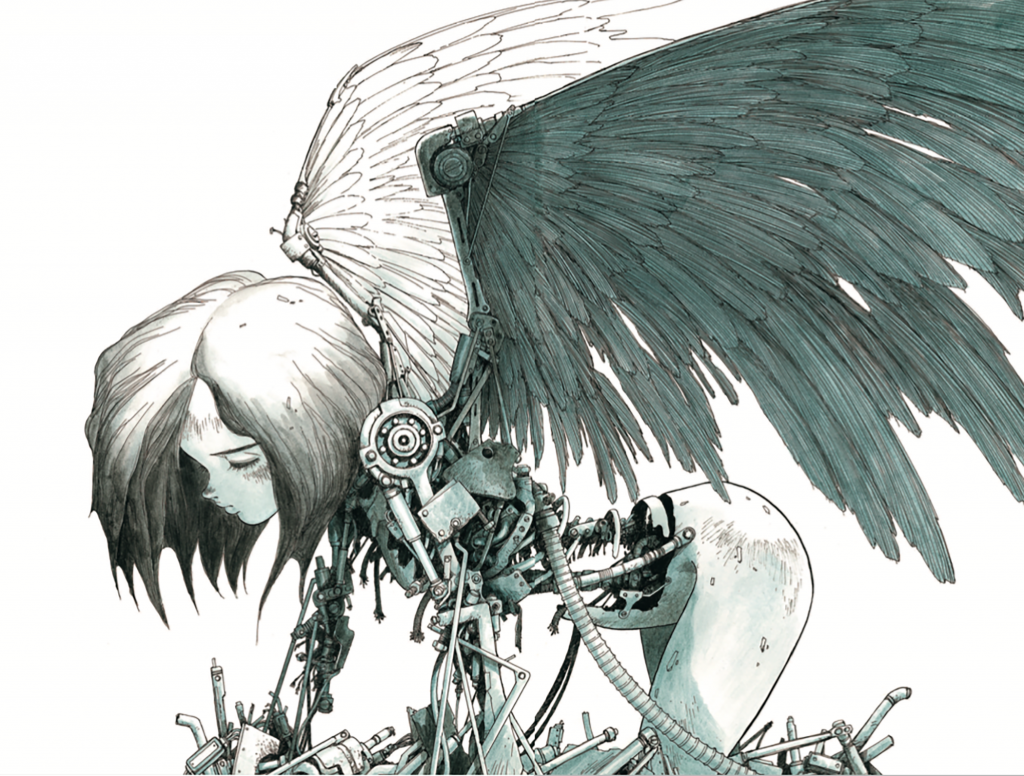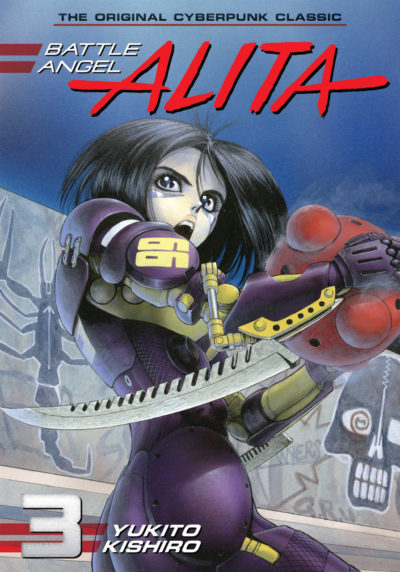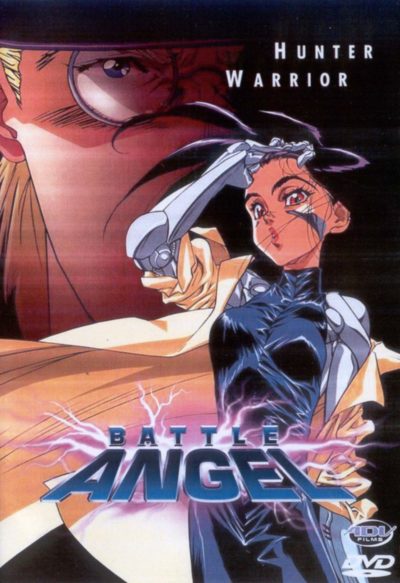With the release of Robert Rodriguez’s Alita: Battle Angel scheduled for February next year, I figured now would be a good time to take a look at the origins of the character. Where did she come from? What is the world she inhabits like? And what might we expect from the film?
The character was created by Japanese manga artist Yukito Kishiro, with the first installment appearing in Business Jump magazine, late in 1990. The 52 episodes plus an epilogue were then collected into nine volumes, and the story is available in that format, both in Japan and translated into English for a Western audience. There have been some changes made, beginning with the title: in its homeland, the series was known as Gunnm, which translates as “gun dream” [something hinted at by the heroine, who at one point says “I was probably a gun or something in my previous life”]. Alita is known as “Gally” in the original version, and the city hovering over her home town was originally Salem, rather than Tiphares. I’ll be using the English language names.
It takes part in a post-apocalyptic version of North America; later installments have said the timeframe is the 26th centure, beginning in the year 2533. The elite have left the surface of the planet, and live in the flying city of Tiphares. Everyone else is still on the ground, supplying the city with all its needs. One of those is Ido, a cyberdoctor exiled from above, who finds a cyborg head in the scrapyard lying beneath Tiphares. He gives it a body, and calls her Alita. Her memories are all but gone; what she does remember, however, is how to fight, being skilled in ‘Panzer Kunst’, a legendary form of martial arts. This stands her in good stead, as she becomes a bounty hunter, tracking down and killing criminals in and around the scrapyard.
 There have been two (or perhaps three) subsequent comic-book incarnations. First was Battle Angel Alita: Last Order, originally published from 2001-14 in Japan. Then came Battle Angel Alita: Holy Night and Other Stories, though this was a collection of four side-stories – hence the “perhaps three”! Most recently, we had Battle Angel Alita: Mars Chronicle (2015-17). Two of the volumes from the first incarnation were adapted into a pair of 30-minute OVAs (Original Video Animation), released in June 1993. Rumblings of a live-action version have been around almost as long, with James Cameron securing the rights to the comic in 1999, having been introduced to the property by Guillermo Del Toro. By the mid-2000’s, a script had been created, but after developing the project in parallel with Avatar, Cameron decided to devote his efforts to that instead, and Alita went on the back-burner.
There have been two (or perhaps three) subsequent comic-book incarnations. First was Battle Angel Alita: Last Order, originally published from 2001-14 in Japan. Then came Battle Angel Alita: Holy Night and Other Stories, though this was a collection of four side-stories – hence the “perhaps three”! Most recently, we had Battle Angel Alita: Mars Chronicle (2015-17). Two of the volumes from the first incarnation were adapted into a pair of 30-minute OVAs (Original Video Animation), released in June 1993. Rumblings of a live-action version have been around almost as long, with James Cameron securing the rights to the comic in 1999, having been introduced to the property by Guillermo Del Toro. By the mid-2000’s, a script had been created, but after developing the project in parallel with Avatar, Cameron decided to devote his efforts to that instead, and Alita went on the back-burner.
The massive success of Avatar led to Cameron committing to not one, two or three but four sequels, with releases dates planned out as far ahead as December 2025. Needless to say, that meant he would not be working on Alita any time soon. In 2015, he gave Rodriguez the script to rework, and was reportedly impressed enough by the result, then to hand over directorial control as well. The results are likely to be somewhat different from Rodriguez’s other works, where he typically does the cinematography and editing as well as his directorial duties. Here, those tasks have been delegated, a nod to the scale of the production. At a reported figure of $200 million, it’s not far off the budget of every other Robert Rodriguez movie combined.
It does not appear to have been a trouble-free journey to the big screen. When the first trailer appeared in December 2017, it came under heavy criticism for the enlarged size of the heroine’s eyes. While a standard feature in much of anime, seeing it in a “live-action” production was clearly unsettling to many people. It was notable that, by the time the second trailer arrived in July, adjustments had been made, and the reaction was considerably better. However, by that point the film had already undergone its first change in release date. Originally scheduled to come out on July 20, in February, it was pushed back to December 21.
But in September, Fox moved the release date again, this time to Valentine’s Day, 2019. This seems to have been a decision to back out of a crowded December market, including Aquaman and new movies from the Spiderman and Transformers universes. Moving it lessens the competition, giving it a couple of weeks before Captain Marvel is released. It’ll also become the first foreign movie after Chinese New Year, which may help its prospects there. That’s now almost eight months it has been pushed back, so you can understand some nervousness among fans. Especially given how much is riding on this.
For Alita: Battle Angel will be the most expensive action heroine film of all time, easily surpassing the $160 million cost of The Hunger Games: Mockingjay – Part 2. [I exclude The Force Awakens, as more a Star Wars film with a female lead, than a “true” action heroine film] That, of course, was the final entry in a series which had already proven its worth at the box-office. The market for live-action adaptations of anime out of Hollywood has also been shown to be precariously soft, most recently and obviously by Ghost in the Shell. If Alita reproduced that movie’s performance worldwide, it would not even cover its production costs.
If it flops, this would be a serious setback to future entries: we would potentially be back at the days of Catwoman where received wisdom was that actresses couldn’t carry an action flick. Right now, all we can do is keep our fingers crossed, for to this point, there have apparently been no test screenings of the full movie by which it can be judged. 18 minutes of various scenes was screened at Comic-Con International in July, and reports at that time said “the movie is going to be a combination of the manga and the OVA with elements of the ‘motorball’ storyline.” Let’s take a look at both of those incarnations, and see whether we might be able to learn what the film may contain.
Battle Angel Alita, by Yukito Kishiro
By Jim McLennan
Literary rating: ★★★★
Kick-butt quotient: ☆☆☆☆½
 I used to read a lot of comics and graphic novels. But when I moved from London to Arizona in 2000, I all but stopped. There are still boxes in our basement, unopened since then, filled with my comic collection. Rare have been the forays into that culture since, beyond the occasional volume of Dirty Pair, for review purposes. Certainly, nothing as extended as deciding to re-read this in advance of the anticipated release of Robert Rodriguez’s live-action movie. Initially, I feared I had bitten off more than I could chew, when I realized the nine-volume series was a total of over two thousand pages of content. Maybe I should have started reading it before mid-October?
I used to read a lot of comics and graphic novels. But when I moved from London to Arizona in 2000, I all but stopped. There are still boxes in our basement, unopened since then, filled with my comic collection. Rare have been the forays into that culture since, beyond the occasional volume of Dirty Pair, for review purposes. Certainly, nothing as extended as deciding to re-read this in advance of the anticipated release of Robert Rodriguez’s live-action movie. Initially, I feared I had bitten off more than I could chew, when I realized the nine-volume series was a total of over two thousand pages of content. Maybe I should have started reading it before mid-October?
In the end, the release date for the movie got pushed into next year, and I blitzed through the comics at about a volume per day, in virtually my usual reading time. I’d forgotten how pacy comic reading can be: if there’s no dialogue, you scan the panels quickly. It’s not as if you stop and admire them, or worry about what exactly is being portrayed. The intent is almost for the visual aspect to go from the page into your subconscious, so you get a visceral “feel” for what’s happening. That’s especially true for something as heavily action-oriented as this, and Kishiro has an amazing flair for it (not least in the area of sound effects!). If you look at an individual frame, you might not know what’s happening; yet put them together, and almost magically, it becomes a coherent flow.
Ho wever, there’s still an amazing amount going on in terms of story-line and universe-building. You can easily see how the feature film will only be able to cover perhaps one-quarter of the series. I presume it will begin with the origin story, in which Ido finds the head of Alita in the scrapyard beneath the floating city of Tiphares, and gives it a cybernetic body. He’s a part-time bounty hunter, only to find out quickly, the combat abilities of his new charge far surpass his own. Unfortunately, she has little or no memory of her prior life; where she got these skills and how she ended up in the scrapyard is only revealed well into the series.
wever, there’s still an amazing amount going on in terms of story-line and universe-building. You can easily see how the feature film will only be able to cover perhaps one-quarter of the series. I presume it will begin with the origin story, in which Ido finds the head of Alita in the scrapyard beneath the floating city of Tiphares, and gives it a cybernetic body. He’s a part-time bounty hunter, only to find out quickly, the combat abilities of his new charge far surpass his own. Unfortunately, she has little or no memory of her prior life; where she got these skills and how she ended up in the scrapyard is only revealed well into the series.
The second volume has her both falling in love, and discovering the pain which love can bring. She is smitten by Hugo, another young orphan of the scrapyard, who is working hard – albeit in some very dubious ways – to raise enough funds to buy a ticket up to Tiphares. When he discovers the truth about his situation, he cracks – and a bounty is placed on his head. The end result is romantic tragedy of a high order, and also drives Alita away from Ido. That brings her into the middle arc: motorball, a superviolent pastime popular among the scrapyard inhabitants. This occupies the third and fourth volumes: Alita climbs the sport’s ladder towards the elite players, and ends up facing off against its brutal champion, Jashugan. It appears this is roughly the arcs which will be covered in the film version, though I’m not sure how far they’ll get into the motorball thread.
The second half sees Alita head into the wastelands, in search of Desty Nova, like Ido another Tipharen exile. She has become an agent working on behalf of the floating city, and against the rebel group of Barjack, which is intent on (literally) taking down Tiphares. While this gives her access to help from above, the flow of data goes both ways: if one Alita is good, wouldn’t a dozen of them be better? Through Nova, she discovers the gruesome truth about the citizens of Tiphares, and her convenient amnesia is also cured, with Alita remembering where she came from, as well as finding out the history which led to the current situation on Earth. She’s left to make the ultimate choice: whether to destroy Tiphares or save it.
It having been more than two decades since I last read this, I’d forgotten almost all the details, so the twists and turns proved highly effective once more. There were several moments where I had to put the book down and just absorb what I’d been told, and Kishiro is good at telling the reader the essential information efficiently. However, it’s the action sequences throughout where he really shines, whether it’s the motorball contests, or the escalating series of battles in which Alita finds herself involved. For no matter how powerful she may become, there’s always someone bigger and badder – likely culminating in Den, leader of the Barjack rebels. Imagine a pissed-off half-horse, half-Transformer. Yeah, he’s like that.
While they certainly would not be cheap, there’s enough material here for a whole franchise of live-action movies, if the first one is a success (fingers crossed, though I’m not optimistic it’ll take in the half-billion or more needed for it to turn a profit). I’m really looking forward to seeing what Robert Rodriguez can do with the adaptation, on the largest cinema screen I can find. Hopefully his vision of Tiphares, the scrapyard and Alita is able to live up to the impressive world created by Kishiro.
Author: Yukito Kishiro
Publisher: VIZ Media LLC, available through Amazon, both as a paperback and an e-book
Battle Angel: The OVAs
By Jim McLennan★★★½
“Sweet, yet too short.”
 Watching this after having read the manga version, it feels like the anime version can do little more than scratch the surface of the world of Tiphares, in the barely fifty minutes it has to work with across its two OVA (Original Video Animation) volumes. The stories here, originally released in 1993, cover the first two section of the manga, and it looks like much of what we see here will also be included in the live-action film next February. Slightly confusing matters, is the way this uses the original Japanese names. So Tiphares becomes Zalem here, and Hugo is Yugo. Most oddly, the heroine is not called Alita – hence the absence of her name from the title – but Gally. To avoid further confusion, I’m going to be consistent with our other articles on the topic, and stick to the translated ones for what follows.
Watching this after having read the manga version, it feels like the anime version can do little more than scratch the surface of the world of Tiphares, in the barely fifty minutes it has to work with across its two OVA (Original Video Animation) volumes. The stories here, originally released in 1993, cover the first two section of the manga, and it looks like much of what we see here will also be included in the live-action film next February. Slightly confusing matters, is the way this uses the original Japanese names. So Tiphares becomes Zalem here, and Hugo is Yugo. Most oddly, the heroine is not called Alita – hence the absence of her name from the title – but Gally. To avoid further confusion, I’m going to be consistent with our other articles on the topic, and stick to the translated ones for what follows.
We see Ido (Kariya) discover the head of Alita (Itou), and almost before we can blink, it’s back to being fully functioning. He’s a part-time cyber-doctor, part-time bounty-hunter, and after Alita follows him – suspecting he’s a killer who is stalking the streets of the scrapyard – she ends up rescuing him from the real killer. She also meets and falls for Hugo (Yamaguchi), a young man desperate to get out of the scrapyard, by any means necessary – a fact that proves to be the source of his downfall in the second OAV. Not present in the manga is the character of Chiren (Koyama). Like Ido, she’s a refugee from Tiphares, who resent his cyber-medical skills and wants to prove herself superior. To do so, she rescues gladiator Grewcica and sets him against Ido’s creation, Alita.
For something a quarter-century old, the animation has stood the test of time well. This is notable in the first part, and especially the battles between Alita and Grewcica, which remain more than capable of getting the blood pumping. The look of the scrapyard and Tiphares have been transferred nicely. The colours feel like your imagination told you they should, from the b&w manga, and even the sound design adds to the atmosphere, both in Kaoru Wada’s score and the groans of the pipes connecting Tiphares to the scrap-yard.
The problem, I think, is a script which doesn’t have enough room to develop the characters and their interactions. Especially short-changed is the relationship between Alita and Hugo, which feels like it goes from zero to passionate love (on her side, at least) in no time at all. As a result, you’re left to wonder why she’s prepared to go to such lengths for him, though his eventual fate remains poignant – not least the addition of a little flourish at the end, where Ido and Alita send up a balloon in his honour. I probably would have felt kinder towards these episodes if I’d seen them before reading the original source material; as is, while solid enough, I can’t help feeling there’s something missing.
Dir: Hiroshi Fukutomi
Star (voice): Miki Itou, Shunsuke Kariya, Kappei Yamaguchi, Mami Koyama













